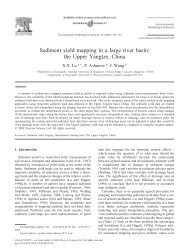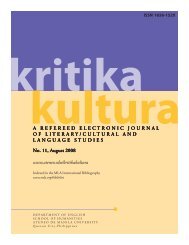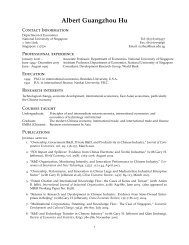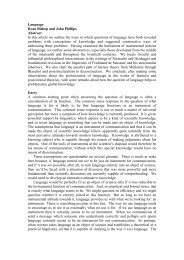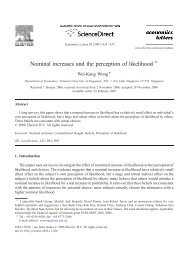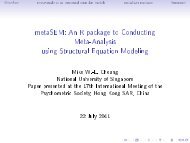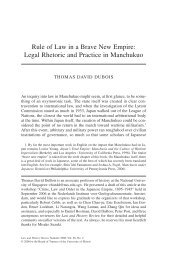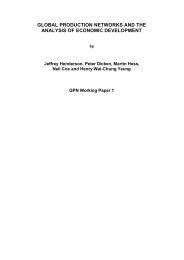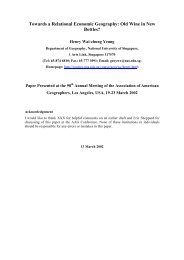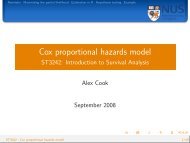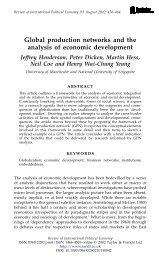The aggregate consumption puzzle in Singapore
The aggregate consumption puzzle in Singapore
The aggregate consumption puzzle in Singapore
You also want an ePaper? Increase the reach of your titles
YUMPU automatically turns print PDFs into web optimized ePapers that Google loves.
570 T. Abeys<strong>in</strong>ghe, K.M. Choy / Journal of Asian Economics 15 (2004) 563–578<br />
Kong—have not witnessed persistent decl<strong>in</strong>es <strong>in</strong> their APCs (Table 1). As we noted earlier,<br />
the <strong>in</strong>itial decl<strong>in</strong>es experienced by these countries <strong>in</strong> the 1960s and 1970s are likely to have<br />
been caused by demographic shifts affect<strong>in</strong>g their work<strong>in</strong>g populations—an explanation<br />
emphasized by the proponents of life-cycle theory themselves (Ando & Modigliani, 1963).<br />
Demographic change has <strong>in</strong> fact been cited as another important factor expla<strong>in</strong><strong>in</strong>g the<br />
upward trend <strong>in</strong> S<strong>in</strong>gapore’s private sav<strong>in</strong>g rate (Husa<strong>in</strong>, 1995; Monetary Authority of<br />
S<strong>in</strong>gapore, 1993). It was argued that the susta<strong>in</strong>ed period of growth experienced by<br />
S<strong>in</strong>gapore co<strong>in</strong>cided with a significant fall <strong>in</strong> both young and old dependents <strong>in</strong> the<br />
population. However, the statistics suggest that if this had any role to play at all <strong>in</strong><br />
expla<strong>in</strong><strong>in</strong>g the APC, it cannot be beyond the mid-1980s, when the ratio of the work<strong>in</strong>g age<br />
population to the total population stabilized at 70%. Yet the APC has cont<strong>in</strong>ued its<br />
precipitous decl<strong>in</strong>e <strong>in</strong> the 1990s.<br />
In a provocative article, Ermisch and Huff (1999) claimed that forced sav<strong>in</strong>g <strong>in</strong><br />
S<strong>in</strong>gapore, extracted through compulsory CPF contributions and the manipulation of<br />
the <strong>in</strong>ternal terms of trade by the major statutory boards provid<strong>in</strong>g utilities and telecommunication<br />
services, have been responsible for the high sav<strong>in</strong>gs rate and hence for<br />
‘‘spectacular drops <strong>in</strong> <strong>consumption</strong> as a share of GDP’’ (p. 30). But it will do well to<br />
remember that private <strong>consumption</strong> as a share of disposable <strong>in</strong>come, and not just GDP, has<br />
also exhibited a pronounced downward trend. Given the way we have measured disposable<br />
<strong>in</strong>come, this suggests that ris<strong>in</strong>g CPF contributions and <strong>in</strong>creases <strong>in</strong> government fees and<br />
charges could not have been the reasons beh<strong>in</strong>d the APC’s decl<strong>in</strong>e. By the same token, high<br />
personal <strong>in</strong>come taxes are not a feasible explanation; as a matter of fact, tax rates have been<br />
progressively reduced over the years. However, <strong>in</strong>creases <strong>in</strong> the CPF contribution rate, by<br />
reduc<strong>in</strong>g disposable <strong>in</strong>come, might have <strong>in</strong>duced people to save more for precautionary<br />
purposes or to meet unexpected cont<strong>in</strong>gencies. We tested this hypothesis of ‘forced sav<strong>in</strong>g’<br />
through the CPF by <strong>in</strong>troduc<strong>in</strong>g the overall CPF contribution rate <strong>in</strong>to the standard<br />
<strong>consumption</strong> function. As expected, its impact was <strong>in</strong>significant.<br />
A potentially important determ<strong>in</strong>ant of sav<strong>in</strong>gs behavior which has not been considered<br />
by exist<strong>in</strong>g studies is the rate of <strong>in</strong>terest (Bl<strong>in</strong>der & Deaton, 1985). In theory, the after-tax<br />
real <strong>in</strong>terest rate is the relative price that <strong>in</strong>fluences <strong>in</strong>tertemporal substitution between<br />
present and future <strong>consumption</strong>. Hence, <strong>consumption</strong> is expected to be negatively related<br />
to movements <strong>in</strong> the real <strong>in</strong>terest rate. Moreover, Deaton (1977) has hypothesized that<br />
unexpected <strong>in</strong>flation could lead to decreases <strong>in</strong> consumer spend<strong>in</strong>g because households<br />
mistake nom<strong>in</strong>al price <strong>in</strong>creases for real price <strong>in</strong>creases. In particular, an absolute rise <strong>in</strong> the<br />
price of all goods and services is confused with a relative price rise for the good that the<br />
consumer is consider<strong>in</strong>g buy<strong>in</strong>g.<br />
S<strong>in</strong>ce it is difficult to calculate the effective tax rate on <strong>in</strong>terest <strong>in</strong>come <strong>in</strong> S<strong>in</strong>gapore, we<br />
<strong>in</strong>vestigated the sensitivity of <strong>consumption</strong> to changes <strong>in</strong> the pre-tax real <strong>in</strong>terest rate. <strong>The</strong><br />
latter is computed as the difference between the prime lend<strong>in</strong>g rate and the annual rate of<br />
change of the CPI—a crude, albeit convenient, proxy for expected <strong>in</strong>flation. We simultaneously<br />
perform a simple test of the ‘‘Deaton effect’’ by add<strong>in</strong>g both the real <strong>in</strong>terest rate<br />
and the actual <strong>in</strong>flation rate as arguments to the <strong>consumption</strong> function. Although the real<br />
<strong>in</strong>terest rate appears to be significant, <strong>in</strong>flation clearly is not, thus reject<strong>in</strong>g Deaton’s<br />
hypothesis. This result is perhaps not surpris<strong>in</strong>g given S<strong>in</strong>gapore’s low<strong>in</strong>flation record<br />
(except for the spikes <strong>in</strong> prices caused by the oil shocks <strong>in</strong> the 1970s). Still, no evidence of



